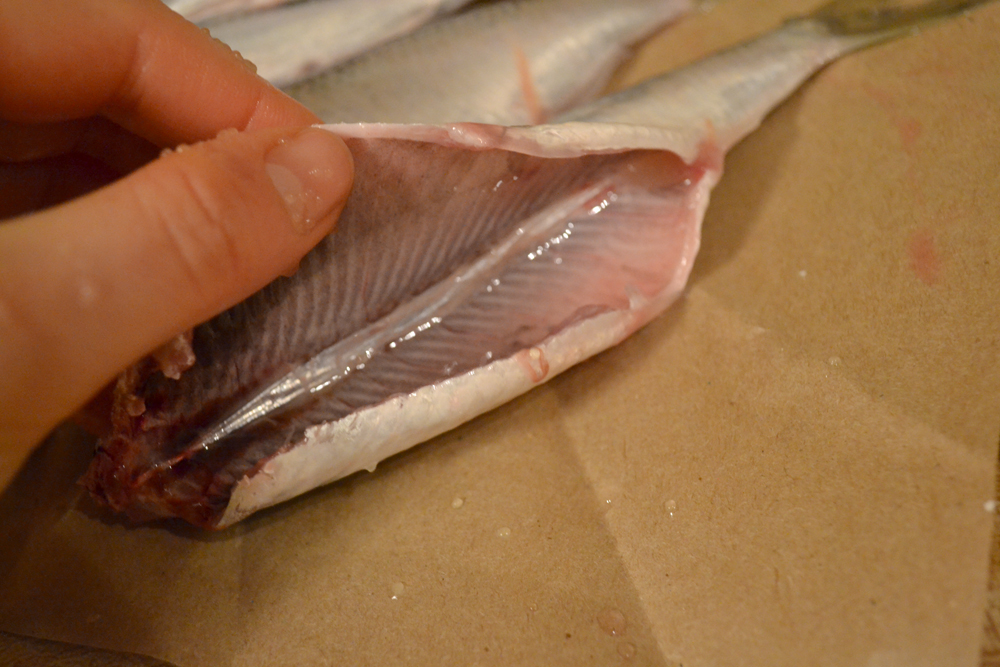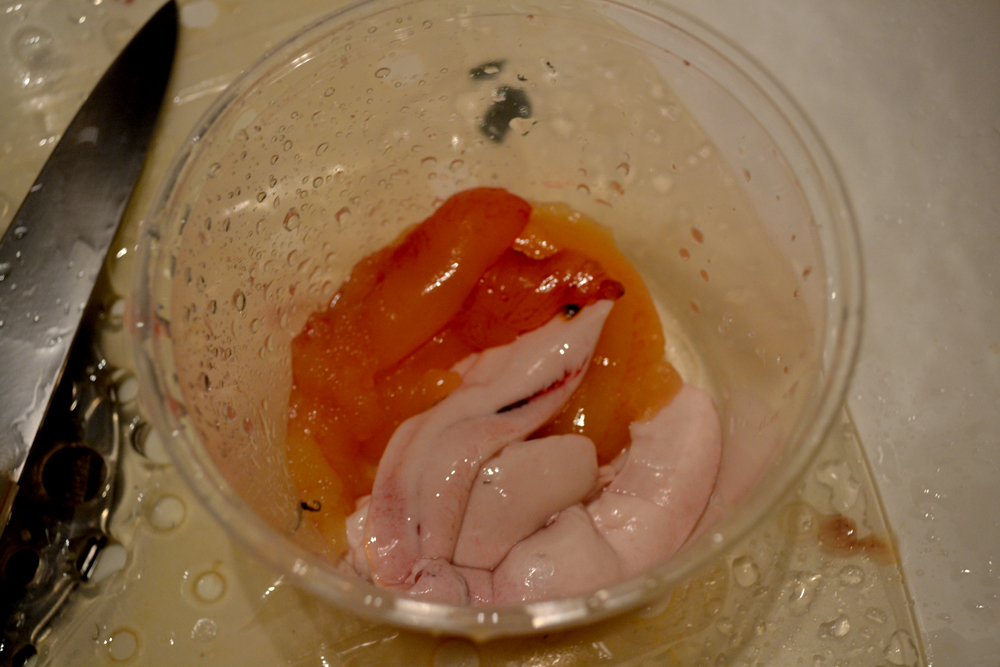
A gleaming school of herring greeted me upon my arrival on U.S. shores yesterday. After landing from Tokyo, my first errand after dropping off my bags at home was a visit to my local fish monger (
Monterey Fish Market). Winter is a cornucopia of goodies for seafood. Crabs, oysters, salmon roe and herring are just some of what I look forward to every winter.
My first taste of
nishin soba (herring over buckwheat noodles) was in its native Kyoto back in 2001. The sweet and tender herring atop a tangle of soba in a hot
tsuyu broth is the perfect compliment to a cold day. After a 10-day eating marathon in Tokyo over the holidays, a bowl of nishin soba was cleansing and comforting. Being back in my kitchen was a pleasure with this fresh catch.
I'll show you how to make nishin soba below, but stayed tuned next week for a second bonus recipe that compliments this dish.
INGREDIENTS
4 whole, uncleaned herring
8 shiitake
2 cups water
1/2 cup sake
3 tbsp sugar
1/3 cup mirin
1/3 cup soy sauce
2 bunches of soba
1/2 cup soy sauce
1/2 cup mirin
3 cups dashi
METHOD
1. Remove scales from fish by running the dull side of a paring knife from tail to head. Rinse the fish as you remove the scales.

2. Clean the insides of the fish.

SAVE the egg or sperm sacs. We will use these for a recipe I'll post next week!

3. Filet the fish.

4. Blanch the filets. Remove from boiling water and rinse lightly with water.

5. Pour the water and sake into a pot and put the filets in the solution.

6. Add the sugar mirin and soy sauce to the pot and heat on the lowest possible setting on your stove. Add the shiitake.

7. Keep the pot on low heat for atleast 20 minutes. The herring should soak up the soy sauce solution. You can keep the pot on low heat for up to 40 minutes, but just make sure the filets don't fall apart.
8. While the filets are simmering, bring a large pot of water to a boil. Add the soba. Boil for 4 minutes.
9. Once the 4 minutes are up, strain the noodles and place in ice, cold water.
10. Heat the
tsuyu (1/2 cup soy sauce, 1/2 cup mirin, 3 cups dashi) until it comes to a rolling boil.
11. Place noodles into bowls, add tsuyu and top with the herring and shiitake.

Herring is so affordable and so fresh during these cold winter months, it's a shame not to take advantage of them. Stay tuned next week for a simple recipe that will utilize the egg and semen sacs!!!
 A gleaming school of herring greeted me upon my arrival on U.S. shores yesterday. After landing from Tokyo, my first errand after dropping off my bags at home was a visit to my local fish monger (Monterey Fish Market). Winter is a cornucopia of goodies for seafood. Crabs, oysters, salmon roe and herring are just some of what I look forward to every winter.
My first taste of nishin soba (herring over buckwheat noodles) was in its native Kyoto back in 2001. The sweet and tender herring atop a tangle of soba in a hot tsuyu broth is the perfect compliment to a cold day. After a 10-day eating marathon in Tokyo over the holidays, a bowl of nishin soba was cleansing and comforting. Being back in my kitchen was a pleasure with this fresh catch.
I'll show you how to make nishin soba below, but stayed tuned next week for a second bonus recipe that compliments this dish.
INGREDIENTS
4 whole, uncleaned herring
8 shiitake
2 cups water
1/2 cup sake
3 tbsp sugar
1/3 cup mirin
1/3 cup soy sauce
2 bunches of soba
1/2 cup soy sauce
1/2 cup mirin
3 cups dashi
METHOD
1. Remove scales from fish by running the dull side of a paring knife from tail to head. Rinse the fish as you remove the scales.
A gleaming school of herring greeted me upon my arrival on U.S. shores yesterday. After landing from Tokyo, my first errand after dropping off my bags at home was a visit to my local fish monger (Monterey Fish Market). Winter is a cornucopia of goodies for seafood. Crabs, oysters, salmon roe and herring are just some of what I look forward to every winter.
My first taste of nishin soba (herring over buckwheat noodles) was in its native Kyoto back in 2001. The sweet and tender herring atop a tangle of soba in a hot tsuyu broth is the perfect compliment to a cold day. After a 10-day eating marathon in Tokyo over the holidays, a bowl of nishin soba was cleansing and comforting. Being back in my kitchen was a pleasure with this fresh catch.
I'll show you how to make nishin soba below, but stayed tuned next week for a second bonus recipe that compliments this dish.
INGREDIENTS
4 whole, uncleaned herring
8 shiitake
2 cups water
1/2 cup sake
3 tbsp sugar
1/3 cup mirin
1/3 cup soy sauce
2 bunches of soba
1/2 cup soy sauce
1/2 cup mirin
3 cups dashi
METHOD
1. Remove scales from fish by running the dull side of a paring knife from tail to head. Rinse the fish as you remove the scales.
 2. Clean the insides of the fish.
2. Clean the insides of the fish.
 SAVE the egg or sperm sacs. We will use these for a recipe I'll post next week!
SAVE the egg or sperm sacs. We will use these for a recipe I'll post next week!
 3. Filet the fish.
3. Filet the fish.
 4. Blanch the filets. Remove from boiling water and rinse lightly with water.
4. Blanch the filets. Remove from boiling water and rinse lightly with water.
 5. Pour the water and sake into a pot and put the filets in the solution.
5. Pour the water and sake into a pot and put the filets in the solution.
 6. Add the sugar mirin and soy sauce to the pot and heat on the lowest possible setting on your stove. Add the shiitake.
6. Add the sugar mirin and soy sauce to the pot and heat on the lowest possible setting on your stove. Add the shiitake.
 7. Keep the pot on low heat for atleast 20 minutes. The herring should soak up the soy sauce solution. You can keep the pot on low heat for up to 40 minutes, but just make sure the filets don't fall apart.
8. While the filets are simmering, bring a large pot of water to a boil. Add the soba. Boil for 4 minutes.
9. Once the 4 minutes are up, strain the noodles and place in ice, cold water.
10. Heat the tsuyu (1/2 cup soy sauce, 1/2 cup mirin, 3 cups dashi) until it comes to a rolling boil.
11. Place noodles into bowls, add tsuyu and top with the herring and shiitake.
7. Keep the pot on low heat for atleast 20 minutes. The herring should soak up the soy sauce solution. You can keep the pot on low heat for up to 40 minutes, but just make sure the filets don't fall apart.
8. While the filets are simmering, bring a large pot of water to a boil. Add the soba. Boil for 4 minutes.
9. Once the 4 minutes are up, strain the noodles and place in ice, cold water.
10. Heat the tsuyu (1/2 cup soy sauce, 1/2 cup mirin, 3 cups dashi) until it comes to a rolling boil.
11. Place noodles into bowls, add tsuyu and top with the herring and shiitake.
 Herring is so affordable and so fresh during these cold winter months, it's a shame not to take advantage of them. Stay tuned next week for a simple recipe that will utilize the egg and semen sacs!!!
Herring is so affordable and so fresh during these cold winter months, it's a shame not to take advantage of them. Stay tuned next week for a simple recipe that will utilize the egg and semen sacs!!!




Comments (7)
Dear Yoko. Thank you very much for your post. I have just cleaned 20 lbs of fresh herring from my catch at the SF ballpark this past Wed. I have a box of herring eggs and sperm sacs and am enthusiastically awaiting your next post on how to prepare them.
We have a bowl full of herring eggs and sperm sacs! Now, we eagerly await your follow-up post. What do we do next? _
Stephen + Ann
Great! Stay tuned for the Thursday post! Wow, did you go out on your own boat or is there some kind of service where you get taken out to the bay? I would love to go herring fishing.
I just made this and I think I made a mistake … there was no flavor. Was I supposed to use the water that I blanched the fish in the whole time? Or change the water?
Hi Christian,
Thanks for trying out the recipe. You were right in changing the water from when the filets are blanched. Did you skip step 6 “Add the sugar mirin and soy sauce to the pot and heat on the lowest possible setting on your stove. Add the shiitake”? The mirin, sugar and soy sauce are what flavor the dish. Perhaps you can add more of these things if you make it again.
Yep, I did it just as you said, left on the lowest heat for around 30 minutes actually. The liquid tasted good too, as I tasted as time went on.
Only difference was that I used dried shiitake, and also I used the tsuyu that came with the soba instead of making it myself. The tsuyu pack that came with it was about 1/3 cup total tsuyu. But I was only cooking for one person.
Ah!! As soon as I wrote that last sentence I think I saw my mistake. Don’t know if this was it or not, but I used only one whole nishin which I then filleted. However, I never changed the amounts of ingredients for the cooking liquid. Would this be my problem?
Hi Christian,
Yes, you may have solved the problem on your own. You may want to adjust the amounts of ingredients to reflect the portion you are making. I hope you try it again and find success!